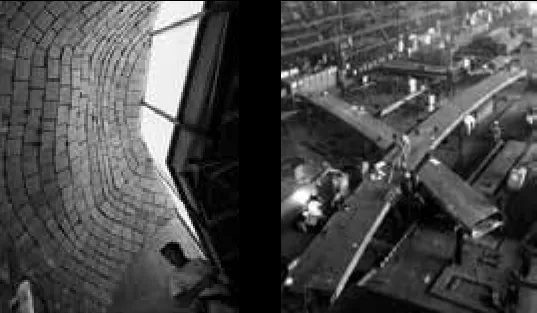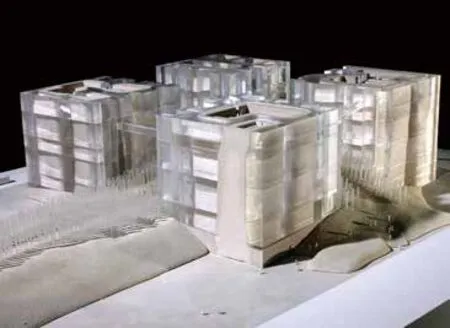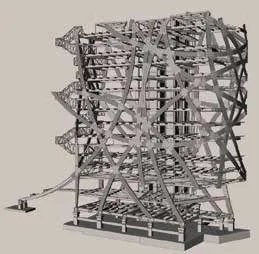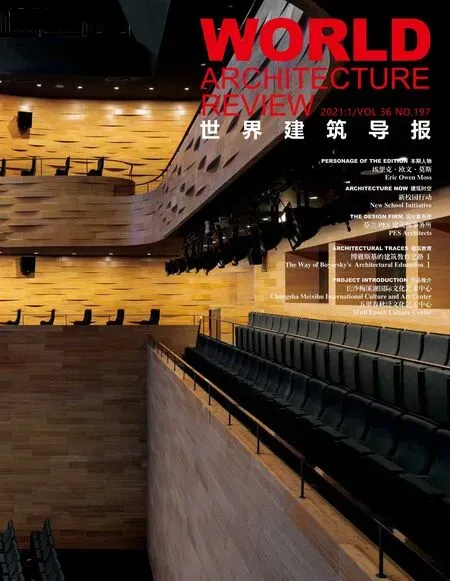人物访谈
导报:随着参数化技术的发展进步,您认为对于建筑师的创作和人们的建造有什么影响?
我认为我具备评估新数字媒体和制造技术方面的优势,原因是我在职场的工作涉及铣削、真空成型和3D打印、机器人等技术出现前后的阶段。
例如,在洛杉矶爱乐乐团(LA Philharmonic)的伞形结构曲面玻璃项目中,那是在前数字化时代,我们必须发明自己的玻璃弯曲技术,并找到愿意试验的分包商。尽管试验期间玻璃碎片破裂了好几次,但最终我们取得了成功。因此,我们要独自承担发明创造,开发新的建筑工具的责任,还要承担成功或失败的责任。有些人认为,曲面玻璃是不可能实现的,或者它太耗费时间,又或者其成本太过昂贵。但我们也得到了富有创造力的玻璃制造商和建筑商的支持,他们勇于接受挑战。
在Trivida项目(同样在前数字化时期)中,我们要用机器切割相同的1000块混凝土块,用手工建造的矩形框来建造一堵曲面墙,然后使用传统的绘图和施工方法搭建一个木制的支撑脚手架。结果每个混凝土块都被切割成了不同的形状。再一次,我们要独自承担发明和实施的责任。
与新的数字工具相比,在概念和构造上的不同之处在于:第一,这些工具使得在制造和构造形状不一、形式各样、空间独特方面更有可能成功,也因此更加常见。这从根本上来说也更加容易。在前数字时代,所涉及的风险只由我们自己承担。现在,人们认为可以将这些挑战变成现实,并且通过每个人都可以接触到的制造和组装过程,可以分担挑战风险。
其次,数字工具的巨大成功反过来又使得构想新形状,设想新空间这一挑战成为一个迥然不同的问题。其中一个选择是,挑战新的软件和新的数字制造和建造工具,而这些方法并不是人们最初设想的。钢结构制造、焊接以及在Wrapper高层中“焊带”的安装,便是一个有关重新发明新工具能力的例子。
导报:在当今建筑市场里,您认为年轻建筑师最需要什么能力呢?
有一个答案是合乎逻辑的,能够熟练掌握了最新的、灵巧的绘图,建模,和制造工具。但关键的问题始终是继续保持好奇,不断思考。当代建筑到底省略/遗漏/忘记了什么?这是年轻建筑师应该问的问题。
如何重新构想形式、空间、材料和目的?就推动概念建筑向前发展而言,新的工具到底能让我们发明什么?让我们重新思考什么?这就是他们将要发现下一个建筑的地方。
导报:您是怎么看待建筑与环境的关系呢?在建筑设计中您是如何回应场地的?
土地属于建筑物;建筑物属于那块地。
去挖掘?去堆积?尽量减少土地改造以减少对环境的破坏?最大程度上进行土地改造,以尽可能地提高对环境的积极影响? 这些是每个项目中都应该询问的关键问题。但是,由于项目的情况和优先次序不同,得到的答复也可能不尽相同。
所建造的建筑和建筑所在的景观之间存在着本质的相互关系,这是一种传统的观念,一种我们应该接受、修改和改进的观念。建筑赋予土地以形式、赋予风景和阳光以联系,赋予公共设施以目的、类型和用途,这是我们在土地使用和气候影响之间相互联系的责任的基础。
例如,水资源的再利用(包括由于水力生产导致的重力下降)以及光伏电池的应用,都是有用的新型组成部分。有目的地利用土地形态本身来塑造场地、建筑空间和项目是一个重要的概念选择,正如从数字计算中衍生出新型玻璃和外部表面镶板类型,由此产生了与太阳隔热膜和内部环境管理有关的更精确的结果。
再一次,个人对土地/建筑主题的好奇心和重新塑造土地和建筑形式解决方案的可能性是其中的关键因素。
导报:您认为建筑如何改变人们对世界的认识?
有些人说,这个世界从本质上来说是已为人们所了解,它以一种我们可以明白和控制的历史模式进行着重复运动。
还有一些人觉得我们不知道的总是会超过我们知道的,总是有更多未知的东西有待我们去发现,我们永远抵达不了发现之旅的终点。此外,在寻找新的概念可能性的过程中,我们也可以想象,那些旧的、曾经有用的观点将会消失。所以不论是眺望未来还是回首过去,如果我们愿意的话,在建筑方面,我们总是可以用新的方式来看待、思考和体验。
建筑是一种价值的表述,目的的表达,也是我们从文化以及社会层面所关注的。它也表达了我们之前所忽略以及回避的内容,我们以往没看到以及忽视的内容。建筑有时也可以呈现价值和目的的另一种概念——一种对以前价值的重新评估。建筑也是这样。所以建筑可以重申文化的规则。也确实如此。建筑是众所周知的。
它可以表达文化的自我修改,适应不同的观察、思考和设想方式。建筑可以挑战文化的规则。如果是这样的话,那就意味着世界及其文化可以是与现在不同的样子,也应该是与现在不同,或许文化听到……
导报:您认为建筑形式的可能性会朝什么方向发展?
具体的建筑形式响应应该是一场个人的讨论,一次只有一个建筑师参与。而设置特定的形式/空间模型或标准是不正确的行为。如果我们这样做,那么这个模型就成为一个可能的目标。我所青睐的目标是需要不断发现形式和空间,而不是一个特定的,接受为他人复制的模式。
无论如何强调社会和环境的优先次序,无可争议的是,形式、形状和空间的力量推动了文化前进,并向文化表明,在建筑方面以及在人类事务的各个方面,都需要不断地去重新评估、重新评价,并用不同的眼光去看待,不同的方式去理解,并使新的有利观点可信。因此,从根本上说,建筑可以发现新的形式和新的空间,而且在重新构想的过程中,建筑可以为文化和个人的重新评价提供教训,并树立榜样。
导报:参数化设计的发展对很多造型前卫的设计过程是否具有重要意义,您是怎么看待类似的建筑领域中新的技术的?
参数化建模方便了复杂建筑物空间的建档和构建。如此,我们可以与制造者、顾问和建造者分享概念过程。然而,这并不能减轻我们重新思考和重新构想的责任,尽管它可能会使得复杂的施工建议变得更容易建造。
奇怪的是,通过使复杂建筑物空间更易于构建,参数减少了复杂建筑物空间的稀有性、唯一性和定义,或者说是参数要求我们重新构想复杂建筑的定义。如果我们说复杂建筑物空间不再复杂,无论从文档还是从可构建性角度来看,我们都要找到一个空间的定义来取代现在传统意义上的弯曲、褶皱扭和曲等等,这些在不久以前还很少见,恰恰是因为它们很难产生。但现在已不同于以往。
在医学行业,经常有关于新型技术工具的讨论,如讨论CAT扫描和MRI,它们提高了精确医疗诊断的能力。有趣的是,随着这些机器的能力的提高以及人们对其的依赖性增强,也有人讨论了医生自身诊断和评估能力的相应下降,原因是机器降低了医生对解释能力的使用。所以从某种意义上说,新技术既增强了医生的能力,也削弱了医生的能力。
对建筑师来说也是如此,因为他们现在相信自己可以通过内置在优先事项中的软件来规定他们的项目内容。就像在医学中一样,在建筑领域,要想减少人类对设计内容的最终责任,软件或新技术不应发挥这种作用。
导报:您的作品大多数都极其富有动感,这种动感的呈现有什么隐喻或想要表达什么特别的意义吗?
我不知道“动态(dynamic)”这个词是否正确。我总是担心思想和概念的深度,以及概念的微妙之处可能会丢失在对某个项目的形状或形式中的最初反应中。我确实有一种感觉,生活经验是运动的、动态的。这就是我所说的‘一场到达移动终点线的比赛’。我感兴趣的是了解我们所构建的世界的可能性-它是什么样子,它可能是什么样子——理解这个主题的困难,以及理解和不可能之间的紧张关系。我认为作品所关注的不是一种或另一种理念,不是一种形式优先于另一种形式,不是对一种被信仰和重复的特定空间形式的拥护,而是形式可能性之间的紧张关系,其中没有任何对一种形式的坚持。
我称之为临时范式,意思是每个项目在形式、空间和目的上都有一个信念,但随后我意识到,有些东西被前一个项目遗漏了,所以总是必须去调整,去重新构想。这意味着概念思维过程应该始终保持动态。
导报:施工结果与最初设计的设想经常会大相径庭,您如何看待这个问题?
有两种方法可以对这个问题作出反应,就建立的东西与绘制的东西而言,这个问题肯定是真实的。第一,我们更希望每一个概念性细节,设想的、已解决的和描绘的都被按照所绘制的那样来实施和建造。
根据具体情况,例如业主、建筑商、国家,我们当然可能会做出一些我们无法始终监控或控制的更改。因此,作为回应,这个项目应该有一种力量、一种信心、一种明确的信念,那就是依赖于设计优先级的层次结构,这样,如果丢失了几个优先级,那么最小的就是妥协的部分,而建筑作为一个抽象物,看起来不会受到牵连。
导报:你的作品所体现的破碎、碰撞和冲突是您预先植入的想法,还是作为设计过程的最终结果,又或者是它们从始至终都贯穿你的设计呢?
在我所说的可能性之间的紧张关系方面,设计的细节是一个前提。如果我承认从一个项目到另一个项目都有规则,那么作为临时的概念或范例,而不是一个不断重复的设计理念或形象,就是一个规则。
问题中使用的词汇更难翻译为建筑。我不认为一个概念的各个部分是碎片化的,至少不认为是相互没有关系的单独的形状或碎片。我认为他们的愿望是希望这些碎片“在下一个项目中”能找到一种聚集在一起的方式或空间?就像一个拼图的碎片,这些碎片分散在一起,但是,也许最终会被拼成一个整体,尽管这个整体还不存在。但可能会。因此,该项目应既提出解决办法,又指出困难之处。
如果你所说的碰撞是指你开车撞到树上这样的意外,是没有料到的情况,那么我不认为碰撞是一个有用的术语。构建碎片之间的相互关系实际上是经过精心管理和组织的,以表明,是的,它们实际上是适合的,结合在一起的,但也许不是以一种观众通常会预料到的方式。是还有待发明一种新的组合。但是现在我们已经在研究的过程中了。这也是我们所期待的。暗示实现这一目标的可能性和困难“而不是不可能”。
导报:您如何看待城市中传统历史与潮流建筑师激进的想法之间的对抗关系?
我想我们经常逃避历史;我们不喜欢历史;我们否定历史。这当然是传统的现代观点。但历史在追赶我们。它驱使着我们,即使我们的反应是坚持自己与历史的形象或规则相矛盾,或者从来不受历史先例的约束。
我曾经想过什么是历史,历史意味着什么,谁决定了历史?很明显,世界各地的建筑、建筑类型、图像和秩序、城市类型都有着几千年的历史。而什么持续下去,什么消失,往往就是一个历史性的偶然事件。什么先例被当作对当代工作的预期,或作为当代思维本身的反面,这些都随着时间的推移而变化。
谁决定哪段历史与我们相关?我的答复是,历史必须是个人的,解释性的,而不是一个简单地回忆画面、地点和日期的问题。建筑常常建立在它自己的基础上,但在最好的情况下,并不是真的这样做--不是轻率的重复,也不是颠倒义不容辞的责任。
对于空间的使用或目的,有可重复的历史形态,这通常与特定历史时间和地点的政治、经济或社会学相关联。随着社会优先事项的不断变化,这些模式常常变得无关紧要。历史模式也有可能重复出现,尽管最初的目的已经被不同的优先次序所取代。重复一种历史上可识别的设计方法或顺序,同时与它的外观相矛盾,就像重复一种视觉上可识别的,与社会目的相矛盾的格式一样,是可以想象的。历史先例的意义和应用体现在个人层面,而非大众化层面。
选择保留什么,拒绝什么,取决于每个建筑师的价值观,过去的时光以及未来的时光——历史作为先例的创立者,既要理解,也要进行辩论。我们的目标是既要理解历史,又要重写历史。
WARA: With the development of parametric technology, what impact do you think it has on architects' creation and people's construction?
I think I have an advantage in the evaluation of new digital and fabrication technologies because the life time of my offices spans a period both before and after the advent of milling, vacuum forming, 3d printing, robotics, etc.
For example, in the Umbrella bent glass LA Philharmonic project, pre-digital, we had to invent our own glass bending techniques and find subcontractors who were willing to experiment.The glass pieces cracked a numbers of times, but ultimately we succeeded.So the responsibility to invent the fabrication and construction tools and to succeed or fail, was ours alone.Some suggested that bending glass wasn’t possible or it was too time consuming, or too expensive.But we also were supported by inventive glass makers and builders who looked forward to the challenge.
In the Trivida project, also pre digital, we had to machine cut 1,000 identical concrete blocks to build a curving wall from rectangular increments, constructed by hand, then produce a wooden supporting scaffold using conventional drawing and construction methods.Each block was cut differently.Again the responsibility for invention and implementation was our alone.
The conception and construction difference with the new digital tools is first, that those tools make the fabrication and construction of unique shapes, forms, and spaces much more likely to succeed, and therefore much more common.Easier in a fundamental sense.In the pre-digital time period, the risks involved were ours alone.Now those challenges are understood to be realizable, and are shared with a fabrication and assembly process to which everyone has access.
Secondly, the very success of digital tools in turn makes the challenge of imagining new shapes, new spaces a very different problem.One option is to challenge the new software and new digital fabrication and construction tools in ways for which those weren’t originally intended.The steel fabrication, the welding, and the installation of the ‘ribbons’ in the Wrapper high rise is an example of reinventing thecapacity of the new tools.

“伞”弯曲玻璃的制造Bent glass fabrication for Umbrella

为Trivida单独切割块(注意背景中的比例物理模型)Individually cut blocks for Trivida (Note scale physical model in the background)

在中国石家庄,为Wrapper项目制造钢架Steel band fabrication for (W)rapper in Shijiazhuang, China
WARA: In today's architecture market, what skills do you think young architects need most?
There’s the logical answer which is to be both up-to-date and dexterous with the most current drawing, modeling, and fabrication tools.But the key issue is always to continue to be curious, to wonder.
What has contemporary architecture omitted/left out/forgotten? That’s the questions young architects should ask.How can form and space and material and purpose be reimagined? What do the new tools allow us to invent, allow us to rethink, in terms of moving conceptual architecture forward? That’s where they’ll find the next architecture.
WARA: How do you see the relationship between architecture and environment? How did you respond to the site in the architectural design?
The land belongs to the building; the building belongs to the land.
To excavate? To mound up? To minimize land modification to reduce environmental disruption? To maximize land modification to maximize positive environmental effects? These are the key questions that should be asked in each project.But the responses will likely be different as the project circumstances and priorities vary.
The idea that building and the landscape on which the construction take place have an essential inter-relationship is traditional, one that we should accept, modify, and advance.That the building gives form to the land, to relationships to view and sun,and to the purpose, type, and use of utilities is fundamental to our responsibility for the interconnection between land use and the consequences to our climate.
For instance, the re-use of water resources including gravity fall for hydraulic power production, and the introduction of photo voltaic cells are useful new components.The purposeful manipulation of the land form itself to shape site, building space and program is an important conceptual option, as are new glazing and exterior surface paneling types derived from digital computation which produce more precise results relative to sun control and interior environmental management.
Again, personal curiosity about the land/building subject and the possibility for reimagining land and building form solutions is the key ingredient.
WARA: How do you think architecture changes people's understanding of the world?
There are those who say the world is essentially understood, known, and that it moves in repetitive historic patterns we can understand and manage.
There are others who feel that what we don’t know will always exceed what we do know, that there is always more to be discovered, and that we will never reach the end of that discovery journey.Further that in the process of searching for new conceptual possibilities, it’s also conceivable that older and once productive ideas will be lost.So both looking ahead and looking back, the possibilities for new ways to see, to think, to experience in architecture are always open if we’re willing to look.Architecture is an expression of value, of purpose, and what we are concerned with as a culture, as a society.It is also an expression of what we’ve ignored, avoided,what we haven’t seen, what we’ve neglected.
And on occasion architecture also has the opportunity to present alternative conceptions of value and purpose, a revaluing of previous values.Architecture does that too.So architecture can reassert the culture’s rules.And it does.Architecture as a known.
And architecture can suggest the culture modify itself, adapt alternative ways of seeing, thinking, and imagining.Architecture can challenge the culture’s rules.And if it does, it suggests the world and its culture can be other than it is, should be other than it is, and perhaps the culture listens……
WARA: Where do you see the possibilities of architectural form evolving?
The specific architectural form response should be a personal discussion, one architect at a time.It’s a mistake to set a specific form/space model or standard.If we do that the model becomes a likely goal.I would prefer the objective to be the ongoing need for discovery of form and space, not a specific, agreed to model for others to replicate.
What’s indisputable, regardless of the emphasis on social and environmental priorities, is the power of form, shape, and space to move the culture, to suggest to the culture that not only in building but in all aspects of human affairs there is a need to continuously revalue, to reassess, to see differently, to understand differently, and to make new vantage points credible.
So in a fundamental way architecture can discover new form and new space and in the process of that reimaging, architecture can teach a lesson, set an example for both cultural and personal reevaluation.
WARA: Is the development of parametric design important for many avantgarde modeling design process? What do you think of the new technology in simiIar architecturaI fieId?
Parametric modeling facilitates the documentation and construction of complex space.It allows us to share the conceptual process with fabricators, consultants, and builders.It does not however alleviate our responsibility to rethink and reimagine,although it perhaps makes difficult construction proposals more readily buildable.
Strangely, by making complex space more buildable, parametrics diminishes the rarity, the uniqueness, and the definition of complex space, or it asks that we reimagine the very definition of complex.If we say complex space is no longer complex, both in terms of documentation and buildability, we have to find a definition of space that supersedes the now conventional bends, folds, twists, and the like which not so long ago were rare, precisely because they were difficult to produce.No longer so.
In another profession, medicine, there are often discussions about new technical tools like CAT scans and MRI’s that have changed the capacity for precise medical diagnosis.Interestingly as the capacity of these machines is increased and reliedon, there is also a discussion of the correspondingly reduced capacity of doctors themselves to diagnose and evaluate precisely because the machines have reduced the need for a doctor’s interpretative skills.So in a sense the new technologies have both strengthened and weakened the doctor’s capacity.

斜杠与反斜杠 Slash and Backslash
That juxtaposition is also possible for architects who now believe they can depend on the software’s built in priorities to define their project content.As in medicine the reduction of the ultimate human responsibility for design content in architecture should not be the software’s or new technology’s role.
WARA: Most of your works are very dynamic.Is there any metaphor or special meaning of this dynamic presentation?
I don’t know that dynamic is the correct word.I’m always concerned that the depth of thought and conception, and the subtleties of a concept may be lost in the initial reaction to the shape or form of a project.I do have a sense that life experience is in motion, kinetic.It’s what I’ve called ‘a race to a moving finish line’.
I’m interested in the possibility of understanding the world in which we build - what it is; what it might be -- the difficulty of understanding that subject, and the tension between understanding and the impossibility of that.I think the work is concerned not with one ideal or another, not with one form priority of another, not with the advocacy of a particular spatial format which is believed in and repeated, but with the tension between formal possibilities, without the insistence on any one.
I have called this a provisional paradigm, meaning each project would carry a conviction in form and space and purpose, but subsequently I would recognize, that something was missed, left out of the previous project, and so an adjustment, a reenvisioning is always mandatory.That means that the conceptual thinking process should always remain dynamic.
WARA: Construction resuIts are often quite different from the originaI design.What do you think of this problem?
There are two ways to respond to that issue, which is certainly real, in terms of what’s built vis a vis what’s drawn.The first is we would prefer that every conceptual detail, imagined, resolved and drawn, is implemented, built as drawn.
Depending on the context, the owner, the builder, the country, for instance, it’s certainly possible that changes will be made that we can’t always monitor or control.So in response, the project should have a power, a confidence, a clear conviction,that relies on a hierarchy of design priorities so that if several are lost, what’s least is what’s conceded, and the building as an abstract, will not appear to be compromised.
WARA: Is the fragmentation, coIIision and conflict embodied in your work the ideas you implanted in advance, or as the end result of the design process, or do they run through your design from the beginning to the end?
The design specifics in terms of what I call the tension between possibilities is a premise.The concept or the paradigm as provisional, not a design ideology or image to be endlessly repeated, is a rule if I acknowledge that there are rules from one project to another.The words used in the question are more difficult to translate as architecture.I don’t see the parts of a concept as fragments, at least not separate shapes or pieces that have no inter-relationship with one another.I think the aspiration is that the pieces might find a way or a space [in the next project?] of coalescing, coming together, like the pieces of a puzzle that are scattered but, perhaps, might finally be assembled as an entity, as a whole, that doesn’t yet exist.But it might.So that the project should suggest both resolution and its difficulties.
I don’t think collision is a useful term, if by collision you mean what happens when you drive your car into a tree - an accident, unintended.The inter-relationships of the building pieces are in fact carefully managed and organized to suggest, yes,they make actually fit, come together, but not perhaps in a way that the viewer would conventionally anticipate.A new kind of unity, that remains to be invented.But is on the way.Again that’s the aspiration.To suggest both a possibility and the difficulty [not the impossibility] of achieving it.
WARA: How do you see the antagonism between traditional history and the radical ideas of trendy architects in cities?
I think we often run from history; we dislike history; we deny history.That was certainly the conventional modern argument.But history chases us.It compels us,even if our reaction is to insist we’re contradicting history’s images or rules, or are never obligated by its precedents.
I’ve wondered what history is, what it means, and who determines that? Clearly there’s a history of building, of building types, of images and orders, of urban typologies around the world for thousands of years.
And what lasts and what disappears is often itself a matter of historic accident.And what precedents are advocated as anticipating contemporary work, or as the inverse of contemporary thinking itself varies over time.
Who decides which history is relevant to us? My response is that history must be personal, interpretative, not simply a matter of images, places and dates to recall.Architecture so often builds on its own antecedents, but at its best, doesn’t do so literally-- not as thoughtless repetition, nor as an obligatory responsibility to reverse.
There are repeatable historic formats for spatial use or purpose often associated with the politics, economics, or sociology of a particular historic time and place.As societal priorities change over time, these models often become irrelevant.It’s also possible that a historic model is repeated, though the original purpose has been replaced by different priorities.
Repeating a historically recognizable design method or order while contradicting its appearance is as conceivable as is repeating a visually recognizable format with a contradictory social purpose.
The meaning and application of historic precedent is personal.The choice of what is kept and what is rejected belongs to the values of each architect, time passed and time future -- history as a setter of precedents to be both understood and debated.The goal is to both understand history, and to rewrite it.

广东省博物馆 Guangdong Provincial Museum

Wrapper大楼

Beehive

